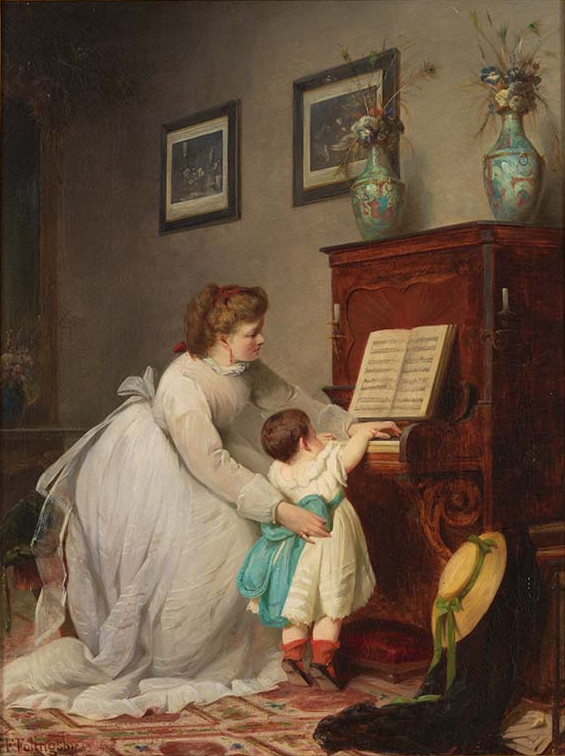We acknowledge the Traditional Owners of the land on which the Queensland Art Gallery | Gallery of Modern Art stands and recognise the creative contribution First Australians make to the art and culture of this country.

G.F. Folingsby / Germany/Australia 1828—91 / The first lesson 1869 / Oil on canvas / 83.5 x 63.8cm / Purchased 1990 / Collection: Queensland Art Gallery | Gallery of Modern Art
G.F. FolingsbyThe first lesson 1869
Not Currently on Display
George Frederick Folingsby’s special skill in painting drapery and costume led to many works featuring full length fashionably costumed women. In The first lesson the elements of patterned rug, cloisonné vases, prints on the wall, and hat and cloak casually positioned to one side act as forms and shapes as well as devices for counterpointing colour notes in the figure studies.
The conventional pyramid structure in the figure composition uses the gaze of the woman at its apex to draw the viewer to the narrative. Her half-seated position allows the artist to explore the texture, trimming and fullness of her gown. The pale grey of her sash is played off in the darker grey of the prints, the grey-green of her hat ribbon and a dramatic reprise is developed with the bright blue-grey of the child’s sash. The use of red is developed in a similar way and extended to major furnishings in the pattern in the rug and in the warm mahogany tone of the timber in the piano.
This painting shows the artist’s wife, Clara, and his daughter. Clara Folingsby was herself an artist who was committed to an insane asylum in Heidelberg, Germany. A few years after her death in 1874, Folingsby migrated to Australia with his daughter.1
Endnotes:
1. This information was obtained from the Folingsby family.
George Frederick Folingsby arrived at Melbourne, Australia, in July 1879 and established a reputation as a portrait painter. From 1882 he was master of Melbourne’s National Gallery Art School. His teaching was a major influence on Australian painting and it formed the basis for several important figure paintings with Nationalist overtones. He also encouraged the combination of figures and landscape.
Several of Folingsby’s works show interior incidents of confrontation or dramatic discovery with the action arranged laterally or diagonally across the space. It is a conventional compositional device adopted by many of his students.
Discussion Questions
1. Take a minute to slowly look at this painting. What did you notice first? Has the artist used a particular method or technique to draw your eye to this section of the painting? Explain your thoughts.
2. Can you identify any items in the picture that may provide a clue that this painting was made a long time ago?
Activities
The artist has painted some objects with decorative patterns and shapes to include in his artwork (clue: look at the floor rug). Be inspired by a couple of different shapes or motifs you can find in the painting to create your own unique design.
Repeat the shape or motif on A4 paper to create a pattern. Using pencils or crayons, add colour to your decorative design.